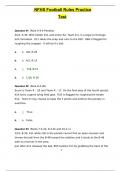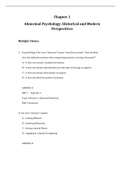Exam (elaborations)
Exam 1: NR224/ NR 224 Fundamentals Skills Exam| Graded A Questions and Answers (2023/ 2024 New Update) - Chamberlain
- Course
- NR 224/ NR224 (NR224)
- Institution
- Chamberlain College Of Nursing
Exam 1: NR224/ NR 224 Fundamentals Skills Exam| Graded A Questions and Answers (2023/ 2024 New Update) - Chamberlain Q: A nurse is working with a nursing assistive personnel (NAP) on a busy oncology unit. The nurse has instructed the NAP on the tasks that need to be performed, including getting ...
[Show more]












